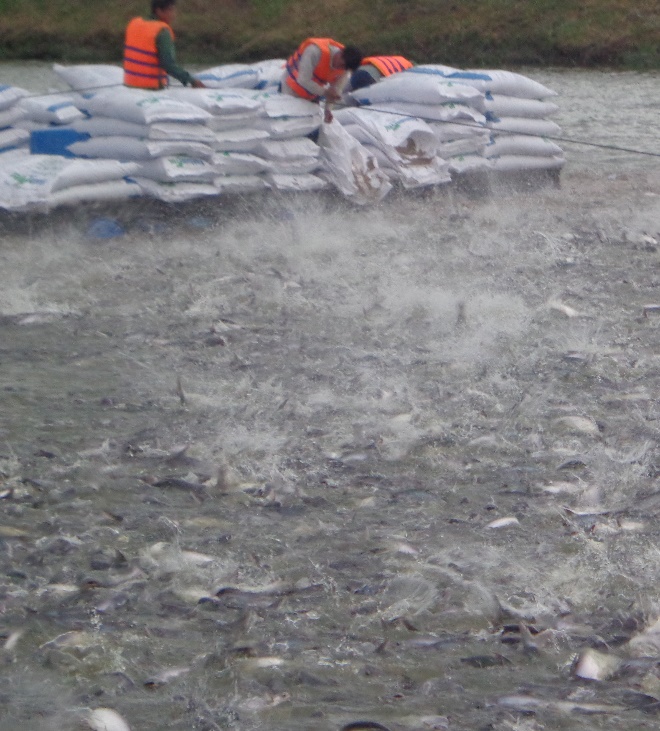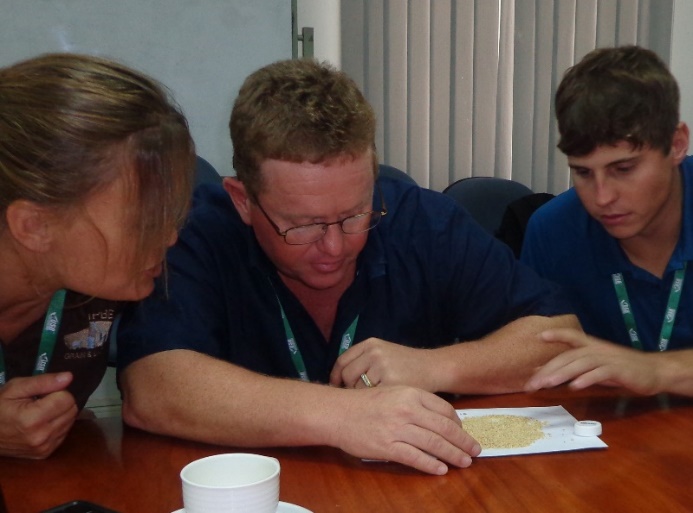 The United Soybean Board (USB) completed its annual summer See for Yourself trade mission to China, which for the first time also included Vietnam. Ten soybean growers from around the country were joined by three USB board members and USB staff along with two ag media representatives, a print journalist and STARadio Farm Director Jim Dewey (WTAD, Quincy, IL). The trip began with a visit to a DuPont facility in St. Louis, MO, on July 30. The group departed the next morning on an early flight to Chicago followed by a 14-hour non-stop trip to Shanghai, China. The Shanghai visit included a trip to a fish farm and a visit from the Deputy Director of the U. S. Consulate Agriculture Trade Office in Shanghai, Zach Henderson. “We also visited a typical Shanghai grocery store on our way to the airport. It was interesting to see the wide variety of oils used by Chinese cooks and a great number of recognizable American made products,” Jim said. “Our flight to Ho Chi Minh City (Saigon), Vietnam, was uneventful, but it brought us to a vibrant, active, modern city of 10 to 11 million people and 6 or 7 million motorcycles. Nearly everyone in HCMC travels on either a motor scooter or small motorbike. The streets are crowded with them,” he added. People hauled goods on their motorcycles. “We even saw one man with an apartment-sized refrigerator strapped to his scooter.” The group’s trip to Vietnam included stops at a Bunge crushing facility, a container port, and a port that can handle large Panamax ships filled with soymeal and other soy products. He continued, “We also visited a catfish processing facility, which employs some 2,000 workers processing thousands of fish every day.
The United Soybean Board (USB) completed its annual summer See for Yourself trade mission to China, which for the first time also included Vietnam. Ten soybean growers from around the country were joined by three USB board members and USB staff along with two ag media representatives, a print journalist and STARadio Farm Director Jim Dewey (WTAD, Quincy, IL). The trip began with a visit to a DuPont facility in St. Louis, MO, on July 30. The group departed the next morning on an early flight to Chicago followed by a 14-hour non-stop trip to Shanghai, China. The Shanghai visit included a trip to a fish farm and a visit from the Deputy Director of the U. S. Consulate Agriculture Trade Office in Shanghai, Zach Henderson. “We also visited a typical Shanghai grocery store on our way to the airport. It was interesting to see the wide variety of oils used by Chinese cooks and a great number of recognizable American made products,” Jim said. “Our flight to Ho Chi Minh City (Saigon), Vietnam, was uneventful, but it brought us to a vibrant, active, modern city of 10 to 11 million people and 6 or 7 million motorcycles. Nearly everyone in HCMC travels on either a motor scooter or small motorbike. The streets are crowded with them,” he added. People hauled goods on their motorcycles. “We even saw one man with an apartment-sized refrigerator strapped to his scooter.” The group’s trip to Vietnam included stops at a Bunge crushing facility, a container port, and a port that can handle large Panamax ships filled with soymeal and other soy products. He continued, “We also visited a catfish processing facility, which employs some 2,000 workers processing thousands of fish every day.  That afternoon included a trip to a catfish farm where we witnessed a feeding frenzy as the fish dined on food that included soymeal as a primary ingredient.” Jim described the trip’s benefits saying, “The 10 farmers on the tour had a good opportunity to learn about both China and Vietnam and why both markets are growing and what buyers in those markets are looking for in soy products.” He noted, “One big difference in the two countries is that China is a more mature market, and the Chinese people are earning more money, which allows them to be more concerned about the type of foods they eat as they add more protein to their diets (mostly animal protein in the form of pork, chicken and fish). The average Vietnamese resident is between the ages of 15 and 40 and earns about $2,500 a year, but that income is also rising, which means Vietnamese appetites will soon be looking for more animal protein.”
That afternoon included a trip to a catfish farm where we witnessed a feeding frenzy as the fish dined on food that included soymeal as a primary ingredient.” Jim described the trip’s benefits saying, “The 10 farmers on the tour had a good opportunity to learn about both China and Vietnam and why both markets are growing and what buyers in those markets are looking for in soy products.” He noted, “One big difference in the two countries is that China is a more mature market, and the Chinese people are earning more money, which allows them to be more concerned about the type of foods they eat as they add more protein to their diets (mostly animal protein in the form of pork, chicken and fish). The average Vietnamese resident is between the ages of 15 and 40 and earns about $2,500 a year, but that income is also rising, which means Vietnamese appetites will soon be looking for more animal protein.”
One item of concern was that U.S. soybean meal had a lot of limestone in it. Shown, left to right, are U.S.  farmers Jennifer Campbell (Franklin, IN), Cap Phillips (Walnut Ridge, AR), and Caleb Frye (Morganza, LA) looking at a sample during a visit to a mill in Vietnam. All were See for Yourself tour members. Visits to both countries were planned by the local offices of the United States Soybean Export Council. “Meals were primarily local cuisine, which meant a lot of fish and tofu. The group also enjoyed local beverages including Tsing Tao beer in Shanghai and 333 beer in Vietnam,” Jim said. Their return trip took 5 and a half hours from Saigon to Tokyo and another 11 and a half hours to Chicago, where they gained back the day they lost on the way over. Jim concludes, “USB put out an invitation to farm broadcasters in March asking if any would be interested in joining the tour. I am very grateful to have been given the chance and will be sharing more stories from the trip in the next few weeks as I have a chance to digest them.” He emphasized, “I would recommend to my NAFB colleagues, that if you get a chance to go on the See for Yourself tour, take it.”
farmers Jennifer Campbell (Franklin, IN), Cap Phillips (Walnut Ridge, AR), and Caleb Frye (Morganza, LA) looking at a sample during a visit to a mill in Vietnam. All were See for Yourself tour members. Visits to both countries were planned by the local offices of the United States Soybean Export Council. “Meals were primarily local cuisine, which meant a lot of fish and tofu. The group also enjoyed local beverages including Tsing Tao beer in Shanghai and 333 beer in Vietnam,” Jim said. Their return trip took 5 and a half hours from Saigon to Tokyo and another 11 and a half hours to Chicago, where they gained back the day they lost on the way over. Jim concludes, “USB put out an invitation to farm broadcasters in March asking if any would be interested in joining the tour. I am very grateful to have been given the chance and will be sharing more stories from the trip in the next few weeks as I have a chance to digest them.” He emphasized, “I would recommend to my NAFB colleagues, that if you get a chance to go on the See for Yourself tour, take it.”
